
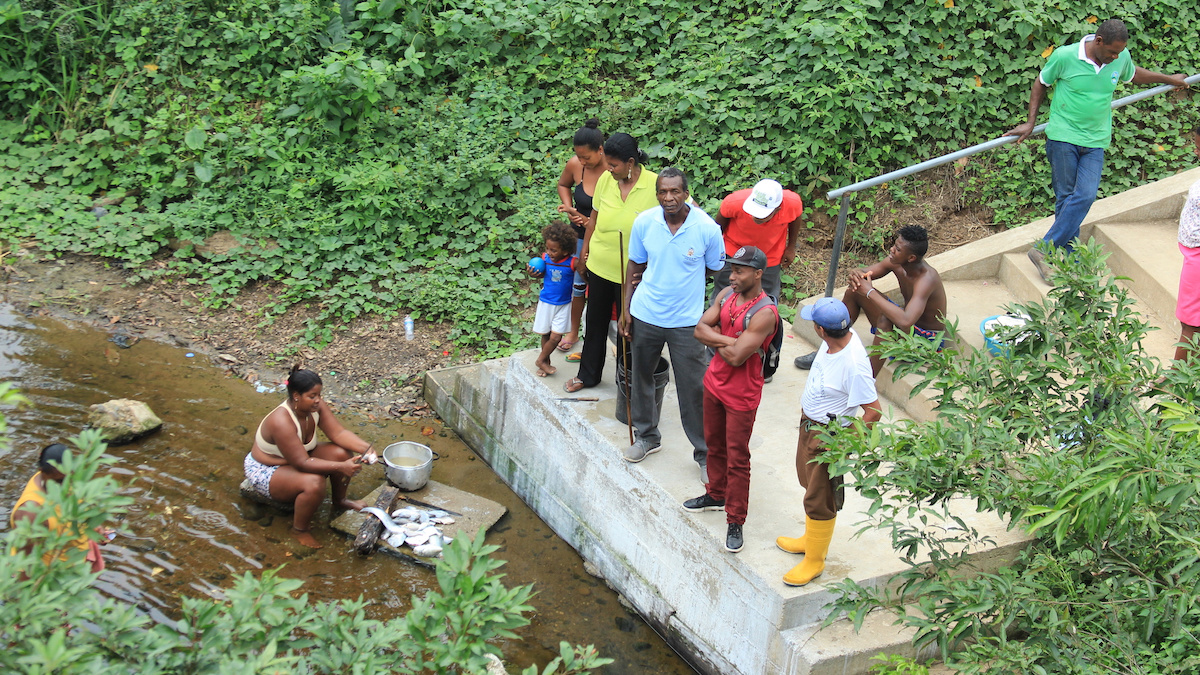
Residents of La Chiquita say they don't have adequate access to safe drinking water. David Silva
By Alejandro Pérez, translated by Romina Castagnino
Fifteen years ago, Martha Valencia relied on the nearby river for water and for food. But then oil palm crops arrived in the area and polluted the river, say Martha and her neighbors. The community took the oil palm grower to court, which ultimately resulted in a ruling in their favor.
“It is determined that there had been serious environmental effects in the territory of the communities … which should have been prevented by the Ecuadorian government,” the ruling read, and a judge ordered compensation for those affected.
That was two years ago. And Martha and her neighbors say they are still waiting for things to change.
No Clean Water
The river and the community, both named La Chiquita, are located within the municipality of San Lorenzo in the Esmeraldas province of Ecuador. Logging and oil palm plantations, in addition to its proximity to the Colombian border where drug trafficking and armed conflict is rife, contribute to the area’s dubious honor of having the highest levels of poverty and violence in the country.
Every eight to 15 days, the municipality sends a water truck to La Chiquita. The tank fills a 1,500-liter blue plastic tank “but not even that water is clean. We were told by the Municipality to put chlorine before drinking it,” says Olga, another community member.
When a new truck does not arrive in town before their tank runs dry, residents say they can buy 20-liter water canisters in San Lorenzo, which last three or four days. However, this option often proves too expensive for community members who must subsist off meager profits from small farms. They say that in that case, they are forced to walk great distances to other rivers.
There’s little in the way of alternatives for people living in the area. According to the National Statistical System and the National Statistics and Census Institute (INEC), 16% of San Lorenzo residents are illiterate, which is more than double the national rate of 6.8%. Almost half of its population is engaged in agriculture and fishing due to a lack of industrial development in the area.
Two years have passed since the Jan. 2017 ruling of Esmeraldas’ Provincial Court of Justice, and those affected in La Chiquita are still waiting for the judge to order the provision of drinking water, among other compensations. The ruling also requires the construction of a health center and a school.
La Chiquita lies in the the Chocó-Darién, an ecosystem that extends from Panama to northwest Ecuador and is known for its unique forests and vast biological wealth – both of which are disappearing at a fast clip due to agribusiness and other human pressures.
Oil palm companies are required to have a buffer zone between planted fields and water sources. They must remove any crops that are located less than ten meters (33 feet) from community water sources and replace them with endemic species such as guadua bamboo. According to former environment ministers, a fine is applied “for obvious negligence in the performance of their duties.”
“It is a historic ruling, although it has objections and inaccuracies that must be corrected in its execution,” says Manolo Morales, a lawyer and representative of the Corporation of Management and Environmental Law (Ecolex) that sponsored the lawsuit.
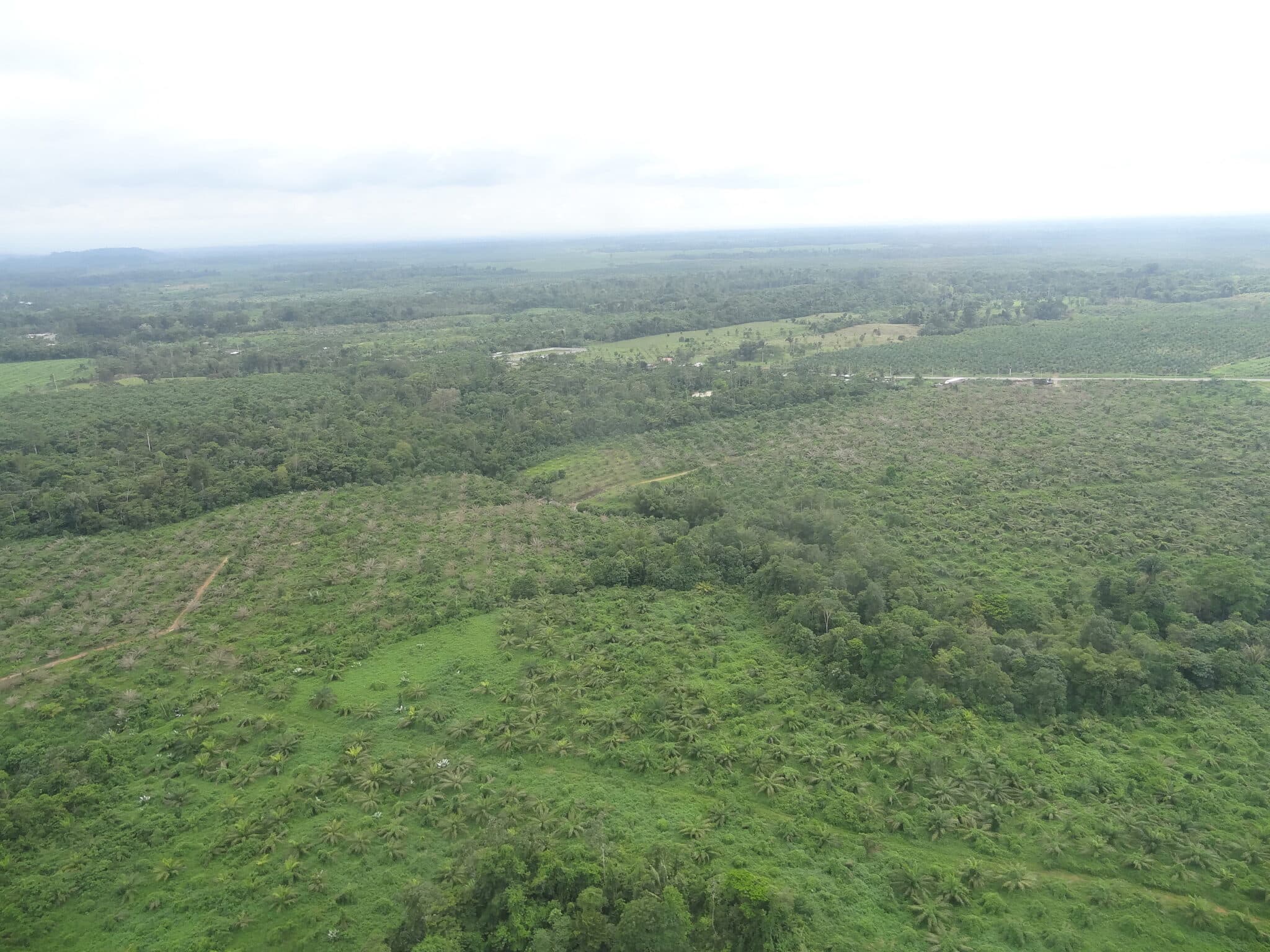
Oil palm cultivation is one of the primary drivers of deforestation in the province of Esmeraldas. Eduardo Rebolledo
The ruling also calls for the Ministry of Environment, together with affected communities, to reforest 500 hectares of degraded land with native species. However, La Chiquita resident Isaha Ezequiel says this is absurd. “Companies are the ones that have polluted and killed the forest but they want us to reforest,” he told Mongabay.
Violence is common in the region. The murder rate in San Lorenzo in 2018 was 96 per 100,000 inhabitants – almost ten times the national rate. The area gained further notoriety that year when a reporting team from the El Comercio newspaper was kidnapped and then killed by FARC dissident groups. The incident occurred in Mataje, a border town near Guadalito, Colombia.
Although four companies were referenced during the trial, two were included in the ruling: Palmera de los Andes and Palmar de los Esteros (Palesema). Only Palmera de los Andes agreed to comment for this story.
Never-Ending Battle
Oil palm plantations in Ecuador cover about 250,000 hectares (617,763 acres) and are distributed among several provinces. Due to its suitable growing conditions, Esmeraldas has the lion’s share.
Palm oil companies arrived in San Lorenzo in the late 1990s and early 2000s, settling in an area of around 30,000 hectares (74,131 acres) that was later expanded to 50,000 (123,552 acres). The inhabitants of La Chiquita, who are mostly the descendants of enslaved people of African ancestry, say local children began to develop stomach diseases and that they noticed oil and pesticide residue in a river that was their primary water source.
When La Chiquita residents went into the forest to investigate the cause of this pollution, they discovered that one of the oil palm growers had installed a palm oil mill less than three kilometers upriver that was dumping liquid waste into the water. The same thing was reported by members of the Awá Guadalito indigenous community, who also joined the demand for change and reparations.
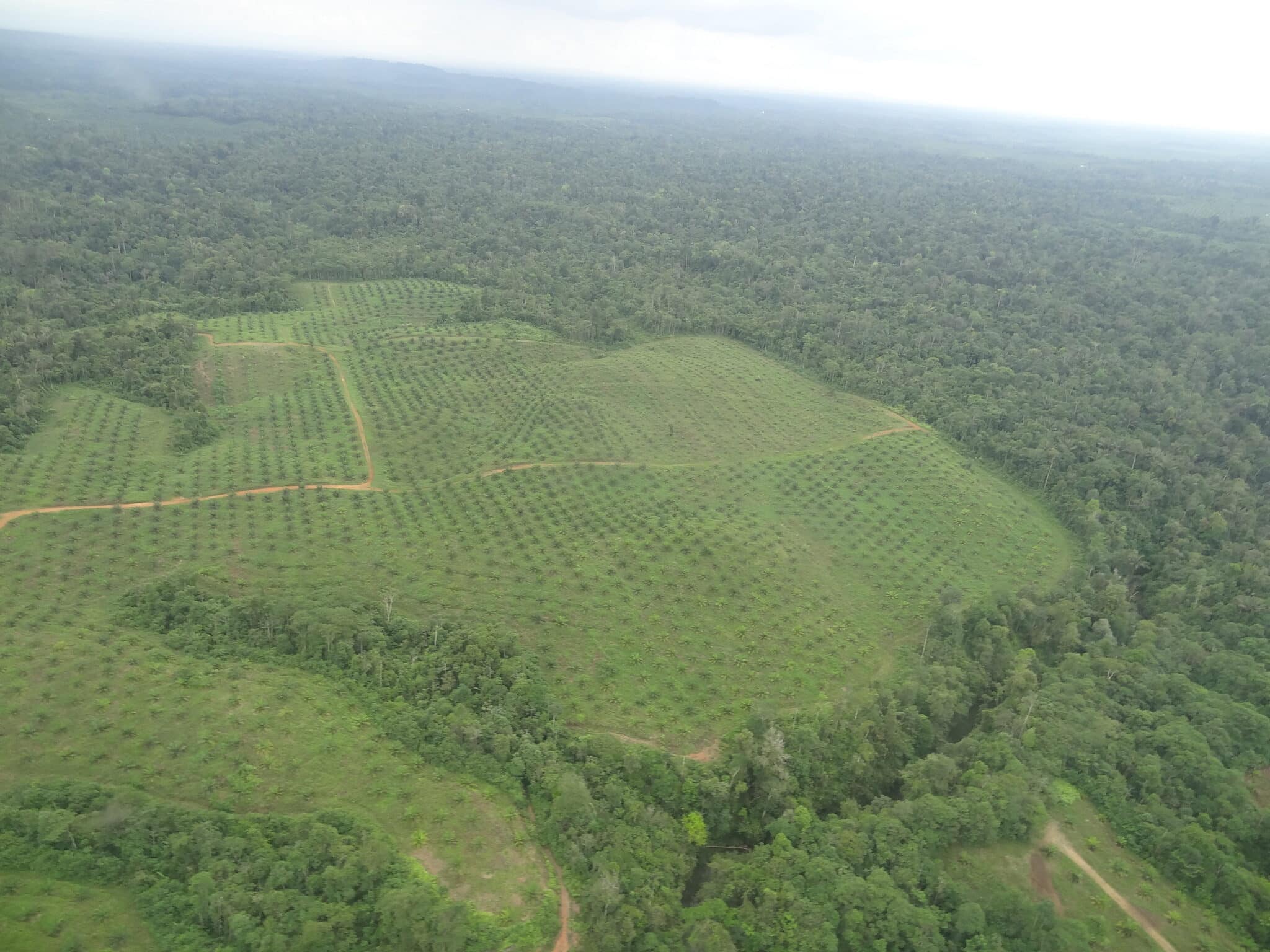
Aerial view of a young oil palm plantation in Esmeraldas. Eduardo Rebolledo
However, a representative of Palmera de los Andes contends claims of pollution.
“We have 11 processing pools with strict environmental controls,” said Fabián Miño, a lawyer and director of the company’s legal department. “It is false that we are the cause of any contamination.” He explained that, after the palm oil refinement process, wastewater is treated in each pool until it is decontaminated. “To confirm that the liquid comes out clean from our building, in the last two pools we have fish and seaweed,” he said.
Miño says communities have been manipulated by NGOs with ulterior motives. He claims Ecolex is an environmental organization that receives funds from abroad, and that the organization attacks oil palm growers to justify its activities and budget regardless of the employment and development opportunities plantations create.
Manolo Morales, of Ecolex, says Miño’s accusations are absurd. He says the organization has worked in the area since 1998 helping local communities gain legal rights to their ancestral territories. He claims that in the intervening years the government promoted and encouraged the cultivation of oil palm and that many inhabitants were persuaded to sell their territories to agroindustry companies. He said he made the decision to advise La Chiquita and Guadalito when he learned of the problems they face.
In 2005, a water quality study by the Al Tropic environmental foundation detected the presence of endosulfan and terbufos in the tributaries that provide water for these two communities. Commonly used as pesticides, these compounds can cause severe illness and death in humans, and the U.S. Environmental Protection Agency classifies both as Category 1 toxins – a designation reserved for the most dangerous substances. This information was included in a report from the Ministry of Environment (MAE) in 2009 and served as the basis for initiating the trial. However, subsequent water studies were not decisive enough to directly hold oil palm companies accountable. Therefore, the judge only partially accepted the claim, ordering the government to fulfill some of the requested reparations to affected communities.
Ecolex reported that oil palm grower companies were alerted by government authorities before officials went to take water samples looking for the presence of toxins. Meanwhile, Fabián Miño, from Palmera de los Andes, claims that the organization was trying to obtain samples of stagnant water.
“They went out of their way to find pollution,” Miño said. “We have all the environmental certifications, national and international.”
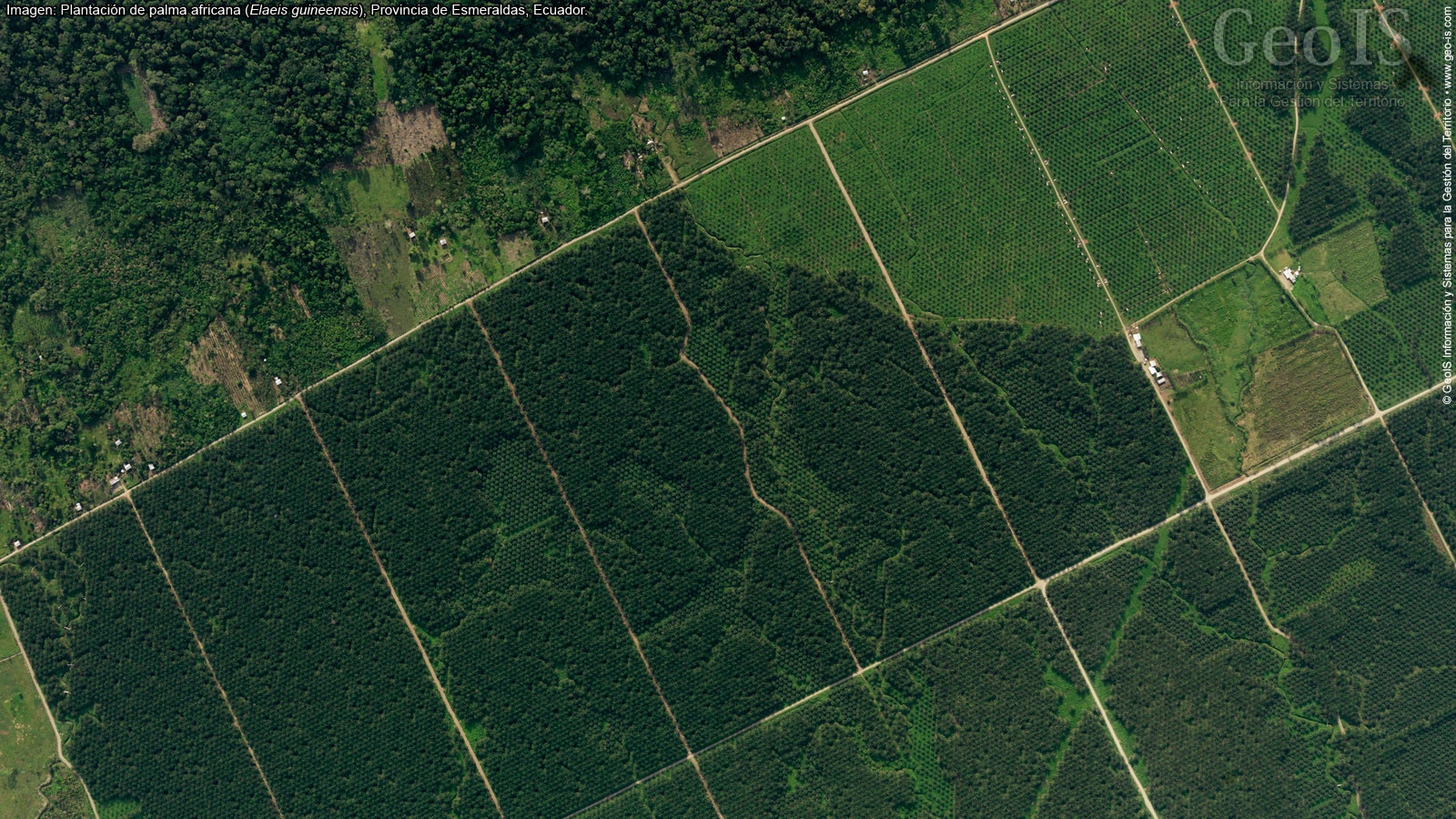
Satellite image of oil palm plantations in San Lorenzo. Rodrigo Sierra
Isaha Ezequiel and his neighbors say two years have passed and they have seen no progress towards court-mandated reparations. According to Nathalia Bonilla, an environmental engineer and coordinator with the NGO Ecological Action in Ecuador, this is because the judge did not report the verdict to the ministries responsible for carrying them out.
Because there is a mountain between the towns of Guadalito and La Chiquita, the judge ordered the building of a school in each. However, Bonilla says the Ministry of Education was also not made aware of this ruling.
Palmera de los Andes reports that it has already begun fulfilling the reparations required by the ruling. However, company representatives say it is doing so because such activities are within its environmental responsibilities and protocols, not because it considers the ruling to be right.
“We are reforesting as required by the ruling,” says lawyer Fabián Miño. He adds that the company has a 1200-hectare (2,965-acre) forest reserve, which was not requested in the reparations, and that the company has an environmental license and provides upwards of 700 jobs to local residents. “They should applaud us and not judge us,” he said.
A Refuge for Many Species
Deforestation in northern Esmeraldas began well before oil palm moved in. In the 1960s, the government implemented its Northwest Forestry Development project that established 14 forest concessions. According to project data, more than 400,000 hectares (988,421 acres) of dense forest was cleared between 1966 and 1975. Five more concessions were subsequently created.
“This is how the primary forests of Esmeraldas were cut down,” says Walter Palacios, a forest engineer and associate researcher at the National Institute of Biodiversity (Inabio). He explains that the primary forests of northwestern Ecuador are home to around 4,000 species of plants, and says many may have disappeared due to habitat loss without biologists ever knowing them.

Oil palm plantations in San Lorenzo, Ecuador. Eduardo Rebolledo
The region’s protected areas preserve what has been lost to agriculture elsewhere: reserves, rich in orchids and giant ferns, extend to the paramos of the Ecuadorian highlands, providing vital habitat for a multitude of species including jaguars and ocelots. A microcosm of the biodiversity of the Chocó-Darién can be seen in just one of its massive trees. A Sande tree, for example, can be covered by as many as 60 species of ferns, orchids and other plants, its fruit important food for birds and insects.
According to Walter Palacios, when the palm plantations first appeared in the area, the secondary forests that had regenerated after the mass clearing of the 1960s were cleared once again.
“A secondary forest no longer has the same species density, it has less wildlife,” Palacios said. “However, it is better to preserve them than to turn them into monocultures.”
Of the region’s remaining primary forest, Palacios says he hopes that the government spares these areas from the expansion of the agricultural frontier.
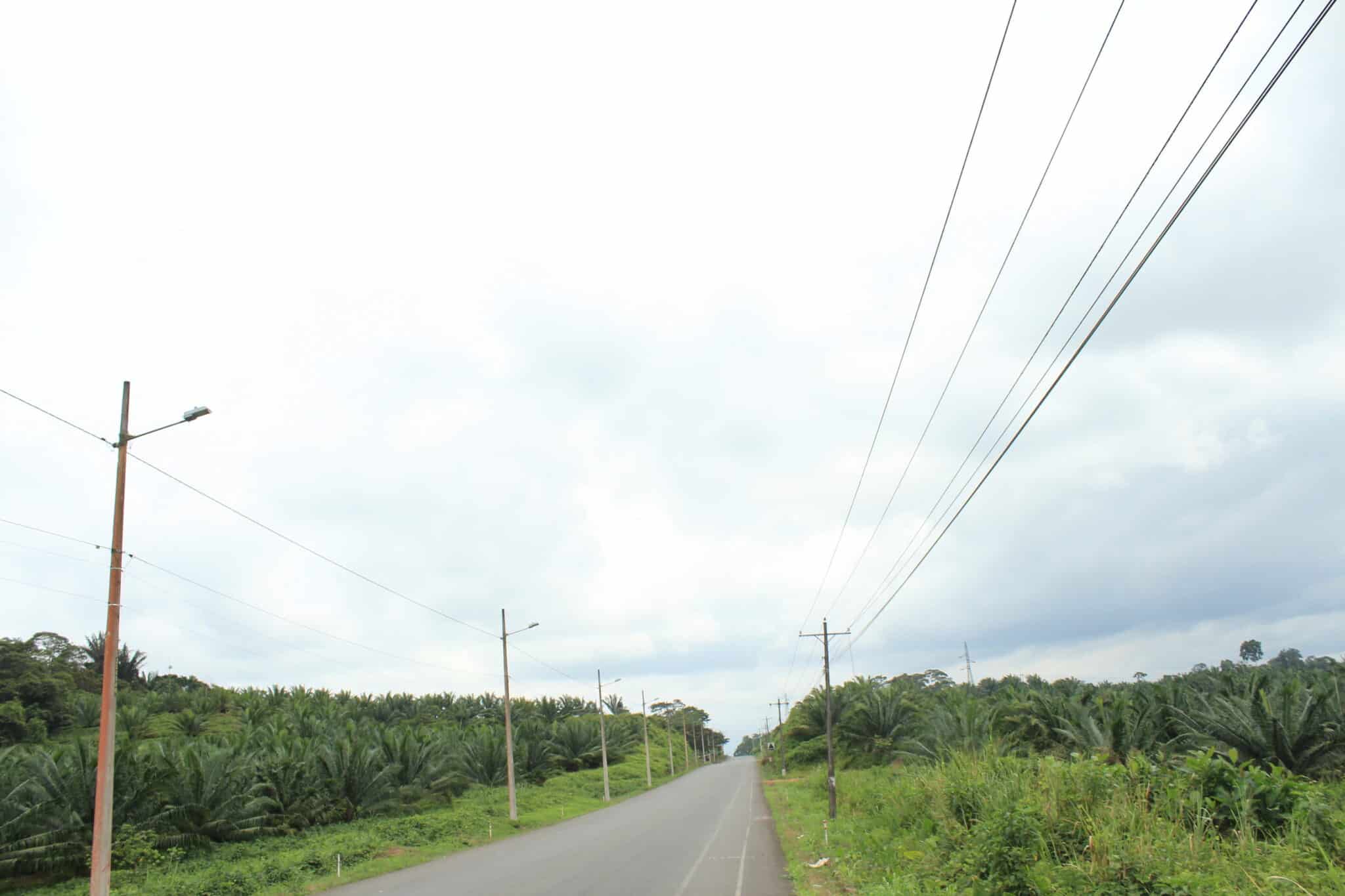
Oil palm crops near the town of San Lorenzo. Eduardo Rebolledo
Residents say conversion of forest to plantations has affected their lives.
“I used to make with my mother wicker baskets out of Piquigua – an endemic plant,” Martha Valencia said. “We used the baskets to transport fish, or the meat of guanta, deer and other animals that we hunted. The forest and the river gave us everything, now we have to go to San Lorenzo to buy the food that was taken from us.”
Residents like Valencia say they know everything they had before will not return in their lifetimes, but that they should still be able to expect clean water. “That is why we need the reparations promised by the ruling,” says Wilberto Valencia, another community member.
The current Minister of Environment in Ecuador is Raúl Ledesma, who assumed the position four months ago. In an appearance before the National Assembly, together with the affected community members, Ledesma offered to further investigate the situation in La Chiquita to verify the damage that Wilberto Valencia and others say is affecting their ability to live. At that same meeting, Ledesma said he was aware that Energy Palma is breaking environmental standards.
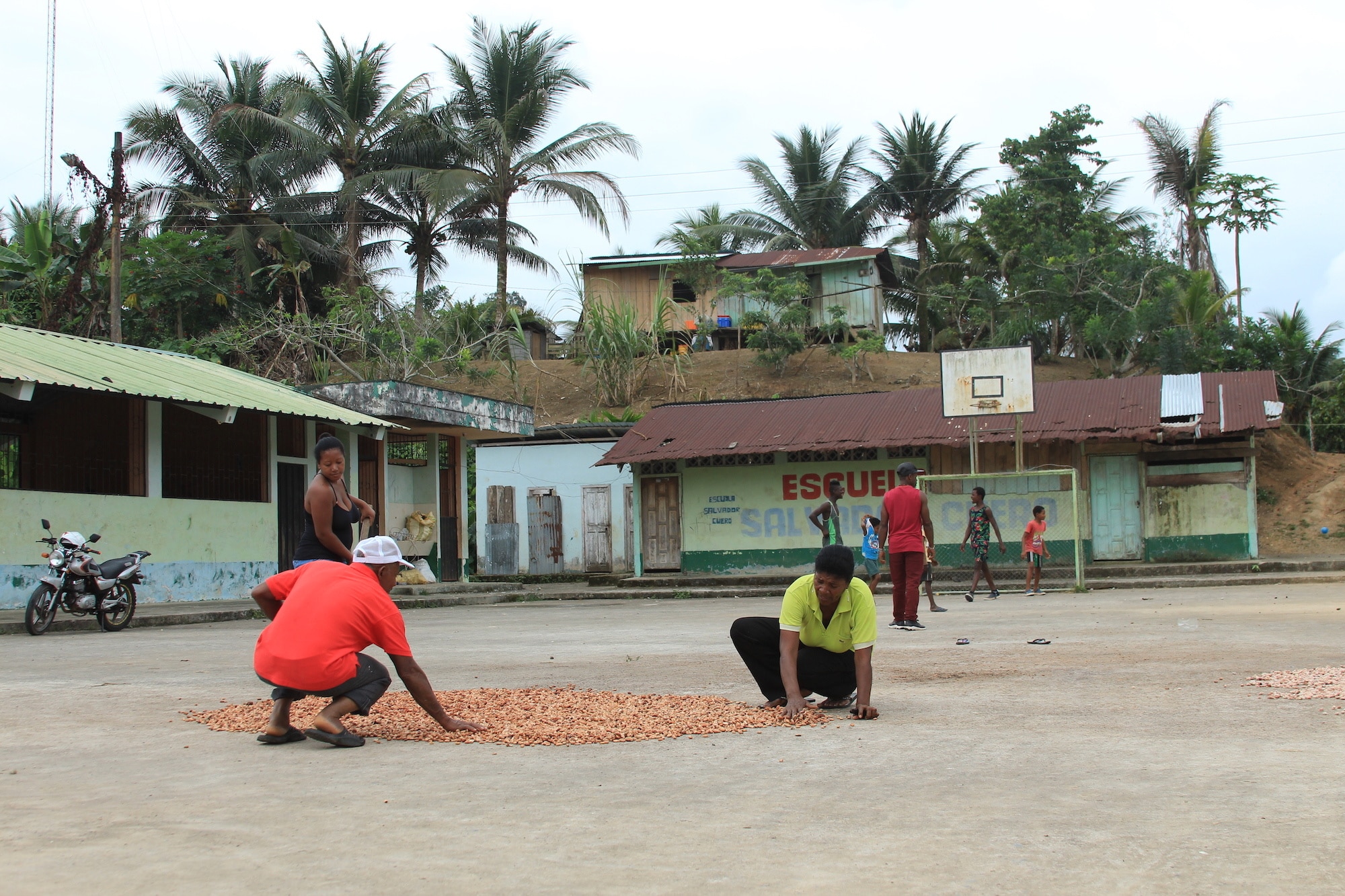
Inhabitants of La Chiquita are fighting against the pollution of their water sources. David Silva
What Does the Future Hold?
Large-scale plantations aren’t the only places where oil palm is grown in Ecuador, and advocates of the crop say stricter regulations on its cultivation could hurt small farmers.
“If there are infractions, justice must act,” says Wilfredo Acosta, executive director of the National Association of Palm Oil Growers (Ancupa). “But 89% are small producers and for us, it is an agricultural activity, like any other, that encourages the development of the country.”
In recent years oil palm crops have been beset with “bud rot.” As of October 2019, the fungal disease had wiped out 15,000 hectares (37,065 acres) of plantations, according to Acosta. His proposed solution: support farmers with credits and provide, through the Ministry of Agriculture, new seeds that are resistant to this disease.
Assemblyman Lenin Plaza, a native of Esmeraldas and president of the Committee on Food Sovereignty, together with Ancupa, is promoting a bill in the National Assembly, which has already passed the first debate. One of its objectives is to double palm oil yields for biofuel production, but Plaza says that does not necessarily mean expanding the agricultural frontier with new plantations. “This will depend on the country’s demand,” Plasa said. “The important thing now is to help the producers.”

Assemblyman Lenin Plaza has proposed a law to increase palm oil production. He says it is necessary to help small producers. Cecilia Puebla
Acosta says oil palm expansion could take advantage of underutilized land once used for agriculture but which has since been abandoned.
“It’s not necessary to expand, it’s about optimizing crops,” Acosta said. “With that, we take the pressure off the forests.”
However, even if the majority of producers may be small, environmental organizations say large companies control around 80% of land used for oil palm cultivation.
“The big companies are the ones that benefit,” said Nathalia Bonilla of Ecological Action. “What they say about small producers is just a story. [Oil] palm is an activity that uses chemicals that seep into the earth [and] needs large areas, and working conditions are precarious.”
Reposted with permission from Mongabay.
- 'I can't get out': Farmers feel the pressure as Ecuador's palm oil ...
- Liberia's biggest palm oil project quits eco-certification scheme ...
- Palm Oil Is Everywhere in India—and Public-Health Experts Are ...
- European banks accused of failing to protect DRC palm oil workers ...
- Community vs. company: A tiny town in Ecuador battles a palm oil ...

 233k
233k  41k
41k  Subscribe
Subscribe 